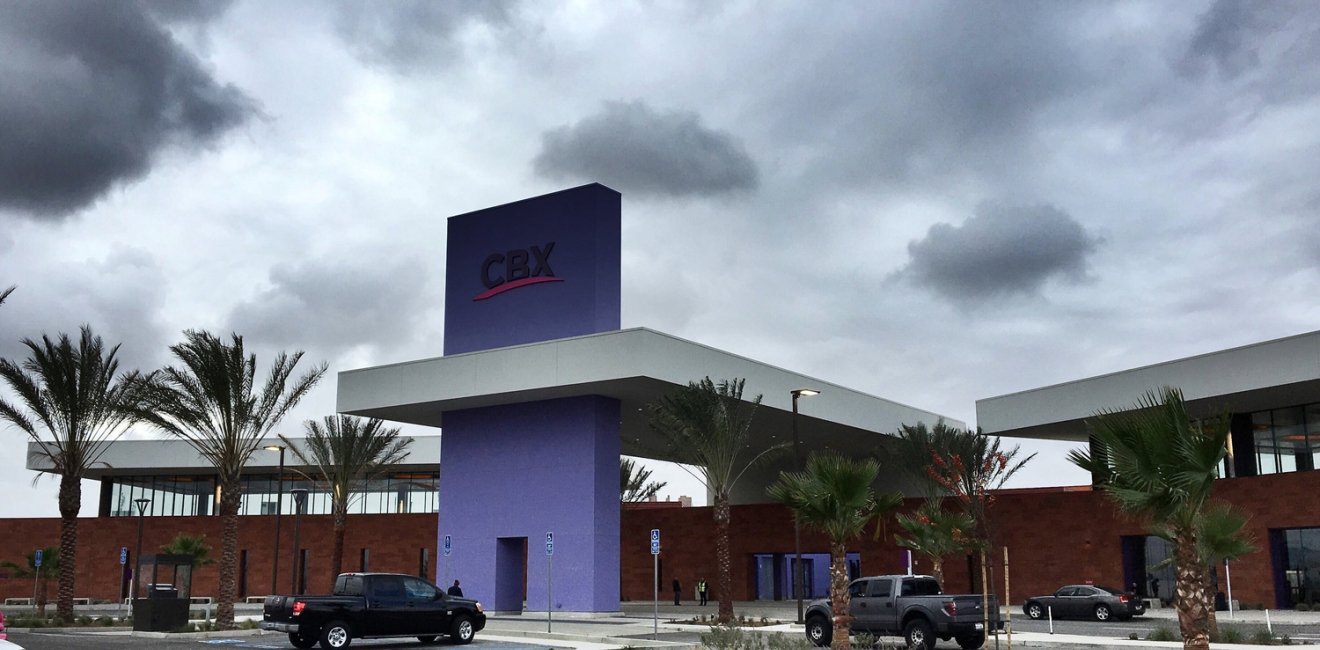San Diego Built a Bridge Over Its Border Wall
The U.S. border with Mexico is no longer a danger that has to be managed but an opportunity worth seizing.
The U.S. border with Mexico is no longer a danger that has to be managed but an opportunity worth seizing.

The idea of building a wall along the U.S. border with Mexico has gained traction again in this election year. The timing may be a little unusual: Illegal immigration from Mexico is negligible these days, with the overall unauthorized population dropping noticeably since 2008. Further, for the first time in decades, there are almost certainly more Mexicans leaving the United States than coming here.
City leaders in San Diego, America's seventh largest city and the only one in the top 10 governed by a Republican mayor, have actually pursued a different approach to the border. Instead of asking for a higher wall, San Diego's leaders decided to build a bridge over the piece of wall they already had. That bridge, a futuristic structure spanning majestically over the border fence below, allows San Diegans to use Tijuana's much larger airport to take flights to Asia and Latin America. Since it was inaugurated in December 2015, San Diego flyers have been able to check into their flights on the U.S. side of the pedestrian bridge, walk across into Mexico, going through immigration and customs as they go, and head straight to their gate at the General Abelardo L. Rodriguez Airport in Tijuana.
The bridge solved one of the city's most vexing problems: the lack of a major airport that could connect San Diego to major cities around the world. The existing airport inside the city couldn't be expanded, and other options were simply too costly. Meanwhile, San Diego's high-tech industries were losing their competitive standing against other cities on the West Coast that offer easy flights to Asia and Latin America. City leaders eventually decided that the best option was to make it easier for people in San Diego to use Tijuana's airport, which already had international flights and was located just across the border. Private investors funded the bridge figuring that the $18 crossing fee would eventually make the venture profitable.
But the airport bridge is only one of the many things going on between two large neighboring cities that once barely interacted with each other. Today dozens of businesses have design and production facilities on both sides of the border, and the area's local governments engage in regional planning together. Museums and cultural organizations frequently offer binational expositions and workshops. Leaders in both cities have even floated ideas for a joint Olympics or World Cup someday, taking advantage of the combined stadium capacity they would have.
For the first time in decades, there are almost certainly more Mexicans leaving the United States than coming here.
This kind of joint thinking would have been impossible a decade or two ago. Tijuana was once one of Mexico's most dangerous cities, a rough-and-tumble industrial town with little cultural life or modern infrastructure. I know -- I lived in Tijuana for five years in the 1990s. It was a city filled with enormous energy and possibilities, but still very rough around the edges.
Public security remains a serious concern, but cooperation between U.S. and Mexican law enforcement agencies has largely dismembered the local cartel that once had a grip on the city. Just as important, pressure from citizens who were tired of living at the mercy of criminal gangs led to major changes in the local police, prosecutors, and courts. Crime levels are a fraction of what they once were.
And in recent years, Tijuana has become one of the most culturally and economically vibrant places in Mexico, with its own large R&D and manufacturing clusters around audiovisual equipment, medical devices, semiconductors, and drones. Just south of Tijuana lie the vineyards in the Valle de Guadalupe, one of the best new regions for wine, and Tijuana's innovative restaurant scene could easily rival that of any city north of the border.
“We are doing so many things together culturally and economically,” says Malin Burnham, one of San Diego's most respected business leaders and philanthropists. “But we could do it ten times faster.” He is worried that bottlenecks at the border make it harder for the two cities to work together, and he's convinced that the future of the region depends on this collaboration. He and a group of city leaders from both sides of the border formed the Smart Border Coalition to push for changes that would make the border work better -- opening more crossing lanes for traffic, pre-clearing trusted travelers, and starting a rail line to get products across the border faster.
In recent years, Tijuana has become one of the most culturally and economically vibrant places in Mexico, with its own large R&D and manufacturing clusters.
The San Diego Regional Chamber of Commerce, headed by former mayor Jerry Sanders, also has been lobbying to make the border more efficient, as has the San Diego Association of Governments (SANDAG), which coordinates planning and investments among all the local governments in the San Diego region. SANDAG hosts permanent representatives of the Tijuana city and Baja California state governments in their offices and has the Mexican government as a full observer on its board, much as it does with several U.S. federal and state agencies. Increasingly its regional development studies focus not just on the San Diego area but on the entire region north and south of the border, since the two economies are so deeply interlinked.
“We built a bridge across the fence,” says Denise Moreno Ducheny, a former state senator who has been involved in many of these efforts and now teaches at the University of California, San Diego, referring to the pedestrian bridge. “It’s a unique symbol of the connection between the two cities.”
But that pedestrian bridge is, in many ways, a metaphor for the many bridges that local leaders in the two cities have been building across the border; bridges that pass over and around the walls that once separated them. In a quiet, pragmatic way, people on both sides of the border have decided that their closeness to each other represents an opportunity to make life for everyone in both cities better and more prosperous, and they've set about planning their future together as a binational metropolitan area. The border is no longer a danger that has to be managed but an opportunity worth seizing.
The opinions expressed here are solely those of the author.


The Mexico Institute seeks to improve understanding, communication, and cooperation between Mexico and the United States by promoting original research, encouraging public discussion, and proposing policy options for enhancing the bilateral relationship. A binational Advisory Board, chaired by Luis Téllez and Earl Anthony Wayne, oversees the work of the Mexico Institute. Read more




